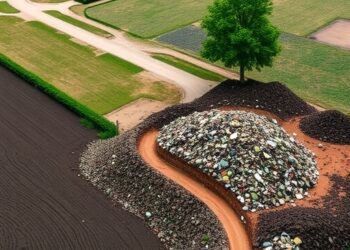The intricate relationship between agriculture and pollinator health is increasingly drawing the attention of researchers dedicated to environmental and ecological concerns. The recent investigation by Tarano, Boumal, and De Toffoli explores a critical question: Could cover crops, often hailed as environmentally friendly agricultural practices, simultaneously pose a risk to pollinators due to the residues of clothianidin found in floral resources? As we dig deeper into this crucial inquiry, one must consider the dual narrative that emerges—a narrative that intertwines agricultural innovation and ecological sustainability with the urgent needs of pollinator preservation.
Cover crops are recognized for their myriad benefits—they improve soil health, prevent erosion, and suppress weeds. Yet, these crops are not devoid of potential dangers. The research focuses on clothianidin, a neonicotinoid pesticide used to protect crops from pests and disease. While it enhances yield and productivity for farmers, its chemical residues in covered floral resources could spell disaster for bees and other pollinators. This delicate balance between agricultural productivity and ecological health is at the heart of the study’s inquiry.
Clothianidin belongs to a class of chemicals that target the neurological systems of insects. While these pesticides serve their purpose in agricultural practices, their residues can persist in the environment, contaminating groundwater and floral resources for an extended period. This raises an alarm for researchers and environmentalists, who note that such residues may be ingested by pollinators seeking nourishment from flowering cover crops, potentially leading to detrimental health effects.
One of the most concerning aspects is the subtlety of the effects that sub-lethal levels of this pesticide might have on bee populations. For instance, even at low doses, clothianidin can impair bees’ foraging abilities, navigation, and overall colony health. The implications are vast: as pollinators struggle, the crops they would typically help to pollinate also face declines in productivity. Therefore, the repercussions extend far beyond individual health issues, affecting ecosystem stability and agricultural economies that rely heavily on animal pollination.
The researchers conducted a series of experiments aimed at isolating the concentrations of clothianidin present in cover crops and their subsequent effects on different pollinator species. Particularly concerning is the finding that various flowering crops used as cover can absorb this pesticide, which then translocates into their nectar and pollen. This dynamic duo—flowering cover crops and pesticide residues—creates a complex web of interactions that researchers must untangle to understand the full impact on pollinator health.
Moreover, the study delves into the fate of clothianidin in the environment. Once released, clothianidin is often found to bind tightly to soil particles, leading to prolonged residues that may not break down quickly. The half-life of clothianidin can extend well beyond a typical growing season, meaning it remains a persistent threat for multiple generations of pollinators that visit the affected flowering plants. This persistence in the environment not only raises concerns for immediate pollinator health but also poses a long-term ecological risk.
The broader implications of these findings are critical for agricultural systems globally. As the world increasingly turns to sustainable farming practices, the interactions between plant protection products and beneficial insect populations must be closely monitored. Policymakers and agricultural experts face the pressing challenge of ensuring that the use of cover crops and other sustainable practices does not inadvertently harm the very pollinators that play a vital role in food production.
To address these challenges, the authors advocate for everyone involved in agricultural practices, from farmers to policymakers, to adopt more informed spraying and planting strategies. Education on the importance of timing and dosage of pesticide application can significantly minimize risks to pollinator health. Moreover, promoting integrated pest management techniques may provide avenues to reduce dependency on harmful chemicals while maintaining crop yields.
In conclusion, while cover crops can provide a sustainable solution for numerous agricultural problems, they also present new challenges regarding pollinator health because of potential pesticide residues like clothianidin. The recent research by Tarano and colleagues sheds light on this vital issue, reminding us that sustainability in agriculture requires a holistic approach—one that encompasses both productive practices and the vital ecological roles played by pollinators. As the urgency of addressing pollinator decline intensifies, findings such as these will undoubtedly guide future research and agricultural policies aimed at fostering a more symbiotic relationship between farming and the environment.
This exploration serves as just one example of the growing intersection between agricultural practices and environmental concerns. Understanding these relationships is critical as we move forward, ensuring that our quest for agricultural efficiency does not compromise the health of our ecosystems, particularly the often-overlooked but essential pollinators.
In the ongoing discourse on sustainable agriculture, it is increasingly evident that researchers must navigate the complex interactions between various agricultural inputs and their impacts on biodiversity. Engaging with these complexities can yield actionable insights that not only promote crop health and productivity but also safeguard our planetary biodiversity for future generations.
Indeed, the journey is not an easy one; however, the insights garnered from the study of clothianidin in cover crops illuminate the path forward. By balancing the needs for agricultural advances with the crucial responsibilities we bear toward our pollinators, we can aspire to an agricultural paradigm that thrives alongside the natural world rather than at its expense.
Subject of Research: The impact of clothianidin residues in cover crops on pollinator health.
Article Title: Are cover crops a potential threat for pollinators due to clothianidin residues in floral resources?
Article References:
Tarano, I.G., Boumal, T., De Toffoli, M. et al. Are cover crops a potential threat for pollinators due to clothianidin residues in floral resources?
Environ Monit Assess 197, 1260 (2025). https://doi.org/10.1007/s10661-025-14741-9
Image Credits: AI Generated
DOI:
Keywords: clothianidin, cover crops, pollinators, environmental impacts, neonicotinoids, agricultural sustainability.




